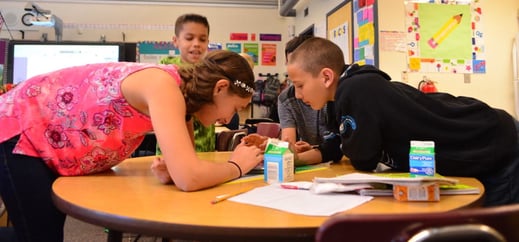
The CLASS® tool’s Instructional Learning Format (ILF) dimension refers to the ways educators enhance engagement. We all know students who are engaged in school regardless of who their teacher is just simply because that is who they are. But, this dimension examines the ways in which educators expand involvement by using a variety of modalities, strategies, and providing hands-on opportunities. This dimension is not about the actual learning that may or may not take place, but rather the “hooks” and methods an educator uses to “set the stage” for learning.
Why is the Instructional Learning Formats dimension so important? To put it simply, if students are not engaged and participating in the learning experiences that educators plan for them, then they are not learning. The more interesting and interactive the lessons are, the more students will participate, which increases the likelihood that students will gain something from the experience. If they are actively participating, they are open and ready to learn, opposed to if they are disengaged they are less likely to learn.
If students are not engaged and participating in the learning experiences that educators plan for them, then they are not learning
Below are three ways educators can boost student engagement:
1) Facilitate Involvement
When facilitating involvement, educators intentionally create meaningful moments for students to wrestle with complex tasks, ask questions, and connect with each other. They circulate around the room making sure students are getting the most out of the materials or activities and modeling or assisting when necessary.
Examples:
- Demonstrating for students how the levers and other materials work during a lab (non-verbal)
- Playing with students as they play a game about new vocabulary (non-verbal)
- Demonstrating movements with students as they skip and hop around the room (non-verbal)
- Asking questions while students are in centers or working in groups (verbal)
- Reiterating directions while students are working in pairs (verbal)
- Clarifying as students are working on an assignment (verbal)
2) Vary Approaches
To gain students’ interest, educators use a variety of approaches. They plan activities that use multiple materials, strategies, and learning modalities. When educators are effective in capturing students’ attention, they allow them to explore and gather the information in a variety of formats or groupings such as whole group, small group, or pairs.
Examples:
- Students collaborate and take turns while following directions for a science lab
- Students work in pairs as they brainstorm a story together
- Students work together to build a bridge using the materials given
3) Focus on Clear Learning Objectives
As an educator, it’s important to know the focus of the lesson. Once educators have a clear idea of the purpose of their lesson or activity and what they want students to take away from the educational experience, then they need to communicate this to their students.
Educators can increase student engagement by helping their students understand “the why” behind what they are learning. By asking questions and making statements that focus the attention on the purpose, core intent, or learning objectives of the lesson or activity, students will know and understand where to focus their attention (as they relate to the goals) throughout the lesson.
Use the activity below to help you reflect on your own methods of incorporating Instructional Learning Formats in lessons. You can also download the reflection guide as a PDF.
Reflect on Your Practice Using ILF
Reflect on a recent lesson. Choose a lesson or activity that you taught recently and reflect on the ways in which you cultivated engagement. Consider how the students were engaged because of your efforts.
Effective Facilitation
1. What were you doing to facilitate students’ involvement?
2. How were you enhancing their engagement as they worked, participated with the activities, and interacted with each other?
Variation in Approach
1. How did you vary your strategies as a way to capture students’ attention and maintain engagement?
2. What hands-on opportunities did you offer your students?
Child Interest
1. In what ways did students demonstrate that they were interested in the activities that you planned for them?
2. Did they: listen, ask questions, initiate involvement, and actively participate?
Clarity of Learning Objectives
1. Did your materials, and activities support your learning goals?
2. Were the questions you asked focused on your learning goals?
3. Did you provide previews, reorientation statements, or summary statements that were focused on the purpose of the lesson or activity?
Now that you have reflected. Take a moment to examine the patterns.
- Where were the strengths of your teaching during this lesson or activity?
- In what areas could you grow based on this lesson or activity?
As you continue to use the Instructional Learning Formats dimension as your guide, consider creating a goal based on what you discovered during this reflection. Perhaps you might even record your next lesson or activity. Reflect again using the above questions.

